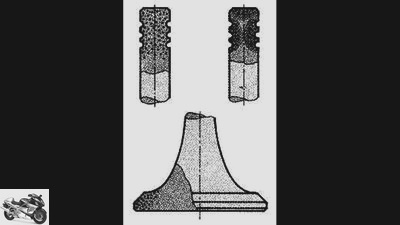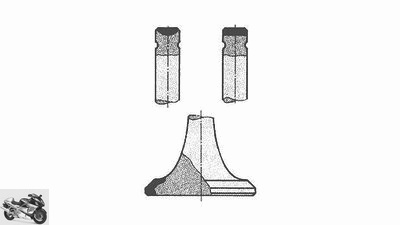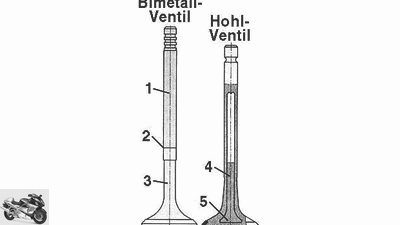Table of contents

counselor
technology & future
Valves: function and designs
Valves: function and designs
Valves: function and designs
The valves are used to ventilate a four-stroke engine. They have the task of sealing the combustion chamber against the ducts during the compression and work cycle and opening up the gas paths during the intake and exhaust cycle.
02/25/2003
The valves are used to ventilate a four-stroke engine. They have the task of sealing the combustion chamber against the ducts during the compression and work cycle and opening up the gas paths during the intake and exhaust cycle. An ignitable gasoline-air mixture enters the combustion chamber via inlet valves, and the burned gases are released into the exhaust via exhaust valves. The enormous thermal loads that occur in the process place high demands on the materials used.
In four-stroke motorcycle engines, two, three, four or five valves are used per combustion chamber. The inlet valves, around which cool fresh gases flow and cool with each intake stroke, reach valve plate temperatures of over 500 degrees. In contrast, the exhaust valves get over 800 degrees. They absorb heat both during the combustion cycle and during the exhaust cycle. The cooling takes place through heat dissipation at the valve seat and from the valve stem to the valve guide.
Steel valves are sometimes made from a single material using a hot extrusion process. More often, however, they consist of two different steel grades. These so-called bimetal valves have a high-temperature-resistant plate made of austenitic steel and a hardenable martensitic steel on the valve stem. Both parts are prefabricated separately and then joined together using the friction welding process.
To improve stability, the valve seat surfaces are often hardened or even armored with special materials. These high-strength special alloys are applied using the fusion welding process. The valve stem ends, which are subject to high surface pressures, also receive similar hardening or armoring. To improve the running behavior, the shafts of steel valves are partially provided with a hard chrome layer only a few thousandths of a millimeter thick or are protected against wear by special hardening processes.
The most expensive type of steel valve is the hollow valve, which is used almost exclusively on the outlet side. In this very expensive valve, the stem and part of the plate are hollow. The cavity is filled to 60 percent with metallic sodium and then closed with a filler piece. The thermally conductive sodium melts at 97 degrees and helps to transfer the heat from the valve head to the stem by constantly moving up and down in the cavity during valve actuation. The temperature reduction is up to 120 degrees. In the past, these valves were used particularly in extremely loaded high-performance engines.
Today titanium valves are used in racing, which results in a weight reduction of 40 percent compared to steel. Some manufacturers are also experimenting with ceramics as a valve material, the weight advantage here is as much as 60 percent. The lighter the valves, the higher the speed and the sharper control times that can be achieved.
Since the cylinder head and the components of the valve train are made of different materials, they expand to different degrees until the operating temperature is reached. When the engine is cold, there must therefore be valve clearance. Excessive valve clearance leads to rattling noises and excessive wear. If the clearance is too small, the valves no longer close properly when the engine is warm and the valves can no longer transfer the heat to the cylinder head. Due to the lack of heat dissipation, the valve seat heats up so much that it burns. The valve clearance is usually kept within the required range by means of shims or screws.
The hydraulic valve clearance compensation works with minimal play and almost maintenance-free. A valve lash adjuster consists of a tappet in which another tappet piston runs. When loaded, i. H. When the valve is open, the oil space between the two is closed by a ball valve. The force of the valve spring to be overcome is transmitted through the oil cushion. If valve clearance occurs, a spring pushes the tappets apart. With the ball valve now opening, the space between the two tappets is filled via the bores connected to the lubricating oil supply until the valve clearance is compensated.
The hydraulic valve clearance compensation is integrated in the bucket tappet. In the case of rocker arms, it sits at the end on the valve side. In the case of rocker arms, it serves as a bearing for the lever in the cylinder head.
Valves with hardened stem ends and seats.

Valve stem ends and valve seats are armored.

Sectional drawing of a bimetal and a hollow valve.
1 = shaft piece
2 = weld seam
3 = head piece
4 = sodium filling
5 = plate cavity
Related articles
-
Schoch 20th pictures 1/20 Typical BMW 2V valve train. It looks similar on many other bumper engines. Schoch 2/20 To set the correct valve clearance, the…
-
Recall Moto Guzzi V85 TT: Intake valves are exchanged
mps photo studio 14th pictures Moto Guzzi 1/14 Moto Guzzi has subtly revised the V85 TT for the 2021 model year. Moto Guzzi 2/14 Three new colors are…
-
Shoei novelties 2020: two new models and some new designs
Motorcycle fair in Milan EICMA 2021 Presented by Shoei. 39 pictures Shoei 1/39 Shoei Glamster (Off White). Shoei 2/39 Shoei Glamster (Basalt Gray). Shoei…
-
Caberg helmet innovations 2020: Horus, Flyon and new designs
Caberg 37 pictures Caberg 1/37 Besides Horus and Flyon there are some new designs. Caberg 2/37 Caberg Drift Evo Carbon. Caberg 3/37 Caberg Drift Evo…
-
Technology of the new Ducati engine
counselor technology & future Technology of the new Ducati engine Technology of the new Ducati engine Now it’s getting tight 13 years ago, the four-valve…
-
motorcycles Buy a used Yamaha TDM 850 Buy a used Yamaha TDM 850 Sound of singles The TDM driver is usually left alone with the standard exhaust noise….
-
BMW 9 pictures Cook 1/9 Lambda probe: This component is located in the exhaust manifold and regulates the injection quantity based on the residual oxygen…
-
Buy used Kawasaki ZX-6R properly
archive counselor Used purchase Buy used Kawasaki ZX-6R properly Kawasakis “smaller” Sportsmen as used Buy used Kawasaki ZX-6R properly Content of…
-
Yamaha counselor technology & future Valve control gas exchange PS technology series part 2 Valve control and gas exchange Content of Almost exactly four…
-
Adjust the valve clearance on the BMW boxer
Schermer counselor workshop Adjust the valve clearance on the BMW boxer Screwdriver tip Adjust the valve clearance on the BMW boxer Thanks to the exposed…